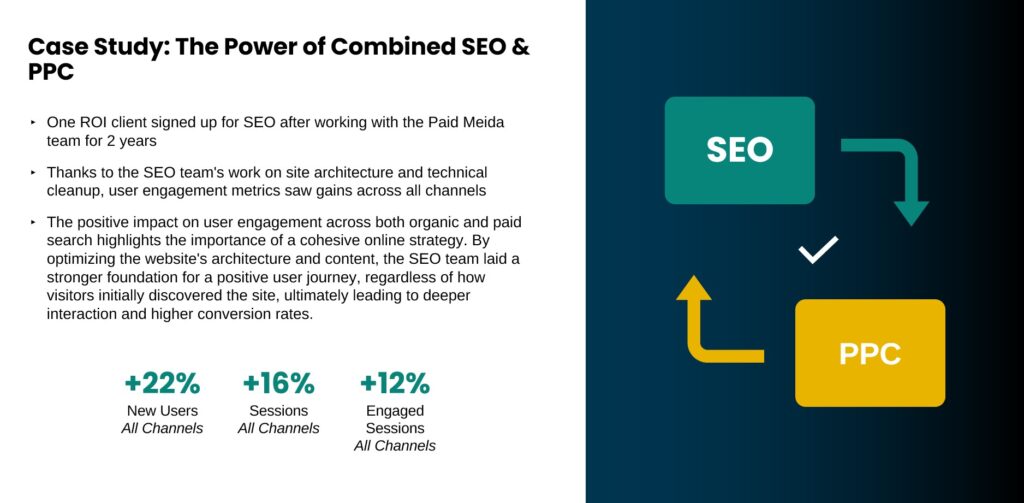Many businesses view individual service channels like SEO and Paid Search as requiring separate strategies; aligning those strategies, however, can be extremely beneficial for your business. So, how can PPC and SEO teams work together in 2025? We’ll share several ways they impact each other and why both channels are essential for your company’s success.
5 Ways PPC & SEO Work Together
1. Increased Visibility & Brand Awareness
When your brand appears in both organic search results and paid ads on the same search engine results page (SERP), you have the advantage of owning more SERP real estate. This makes your brand more visible and allows you to capture more market share. The more often your brand appears in front of potential customers, the more likely they are to notice and trust it.
By combining SEO efforts with their PPC team, one ROI Revolution client achieved a positive boost in user engagement metrics. New user acquisition increased 22% month-over-month after the SEO team cleaned up the website’s architecture and helped improve overall organic visibility in the search results.

How It Works:
- More Click Opportunities: When users see your website multiple times in the SERPs, they have more opportunities to click. Even if they scroll past your ad, they may still click on an organic listing.
- Authoritativeness & Trustworthiness: When a brand appears multiple times in the SERPs, users often assume the brand is a leading player in the industry. This gives your business more credibility.
- Higher Click-Through Rates (CTR): When a brand appears in both organic and paid search results, the overall CTR for that keyword tends to increase. Again, even if a user scrolls past your first result (an ad or an organic listing), they may click the next one.
- Keeps Competitors Away: When you don’t run Paid Search ads for terms where you rank organically, you may be giving up opportunities to your competitors to capture those placements. Running PPC ads reduces the risk of losing clicks to the competition.
2. Build Brand Trust
Utilizing both paid ads and organic listings builds trust in your brand with a strong, cohesive online presence. Tactics like optimizing landing pages with relevant keywords from ads, adding useful internal links, and making sure the copy in the ad matches what is on the landing page can work together to improve ad quality scores and create stronger organic landing pages.
3. Data-Driven Insights
When your business has SEO and Paid Search efforts running simultaneously, they allow you to better understand your customers through multiple data sources, including Google Ads, GA4, and Google Search Console.
If you connect Google Ads with Google Search Console, you can view the Paid & Organic Report, which will give you helpful insights and tips to understand and improve your holistic online presence.
When you have more comprehensive data to analyze, you can make better marketing decisions to connect with your users and meet your goals. Knowing which factors influence a user to convert – i.e., which keywords or messaging drive clicks – can help you make better decisions for both channels.
4. Better Keyword Targeting & Understanding
Keyword performance on Paid can help drive strategy for Organic and vice versa. If a term is performing well, it reveals opportunities to build on that success on other channels.
You can also look at which queries generate clicks from organic search results, for example, and/or have high click-through rates. These high-performing keywords can then be added to your PPC strategy. It can also work the other way around; seeing what works well in a paid ad could also work well as an organic title tag or meta description that attracts clicks.
5. Conversion Optimisation & User Re-Engagement
Not every visitor converts on their first visit, but combining SEO and PPC can help bring them back. By using PPC remarketing, you can re-engage users who first discovered your brand through organic search.
For example, if someone visits your website through an organic blog post but doesn’t convert, you could use PPC ads to retarget them with a relevant offer or reminder. This approach helps you get the most out of your SEO traffic by keeping your brand top of mind and guiding potential customers back to your site when they’re ready to take the next step.
Maximize Your Marketing Efforts
When SEO and PPC work together, they amplify your online presence, drive more qualified leads, and improve overall ad performance, ultimately boosting your revenue. By leveraging both and building collaborative strategies, you can reach the right audience at the right time and maximize your marketing efforts. Ready to take your SEO and Paid Search strategy to the next level? Let’s connect and create a plan that works for your business. Book a meeting today!






